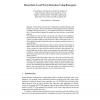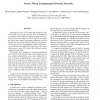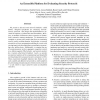92 search results - page 4 / 19 » Design space and analysis of worm defense strategies |
RAID
2004
Springer
13 years 11 months ago
2004
Springer
Worm detection systems have traditionally used global strategies and focused on scan rates. The noise associated with this approach requires statistical techniques and large data s...
CCR
2004
13 years 5 months ago
2004
Distributed denial-of-service (DDoS) is a rapidly growing problem. The multitude and variety of both the attacks and the defense approaches is overwhelming. This paper presents tw...
DSN
2009
IEEE
14 years 16 days ago
2009
IEEE
Topological worms, such as those that propagate by following links in an overlay network, have the potential to spread faster than traditional random scanning worms because they h...
ANSS
2005
IEEE
13 years 11 months ago
2005
IEEE
We present a discrete-event network simulator, called Simnet, designed specifically for analyzing networksecurity protocols. The design and implementation is focused on simplicit...
IPCCC
2007
IEEE
14 years 2 days ago
2007
IEEE
— Localized scanning is a simple technique used by attackers to search for vulnerable hosts. Localized scanning trades off between the local and the global search of vulnerable h...



